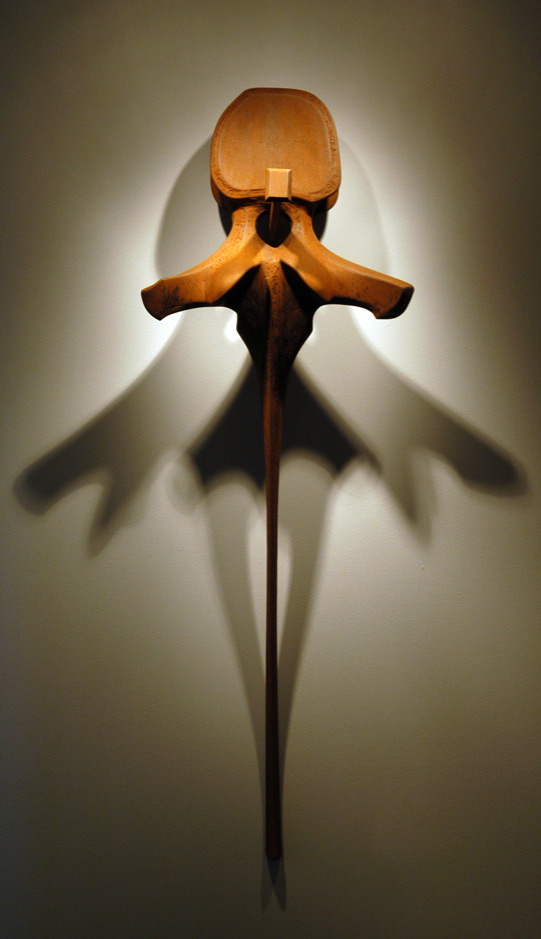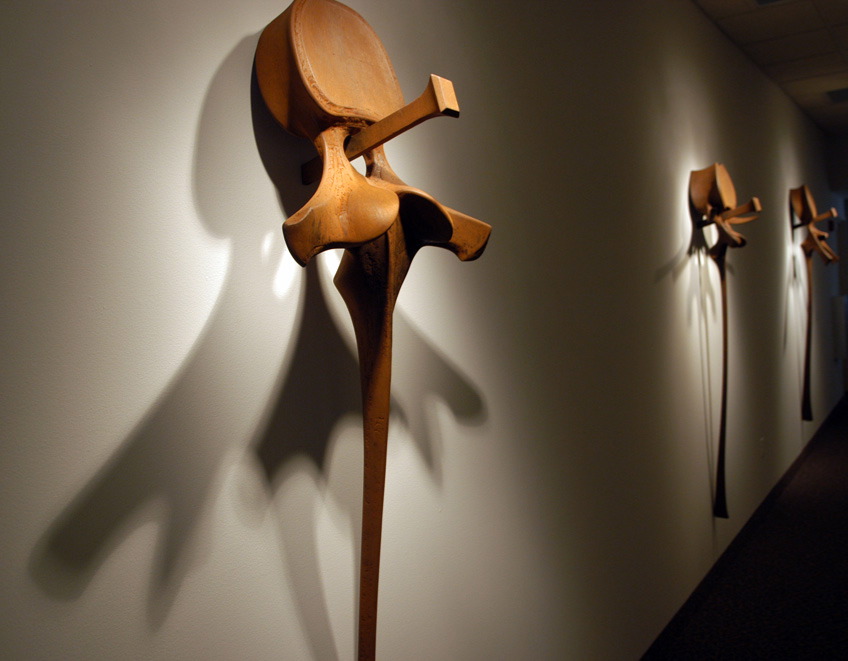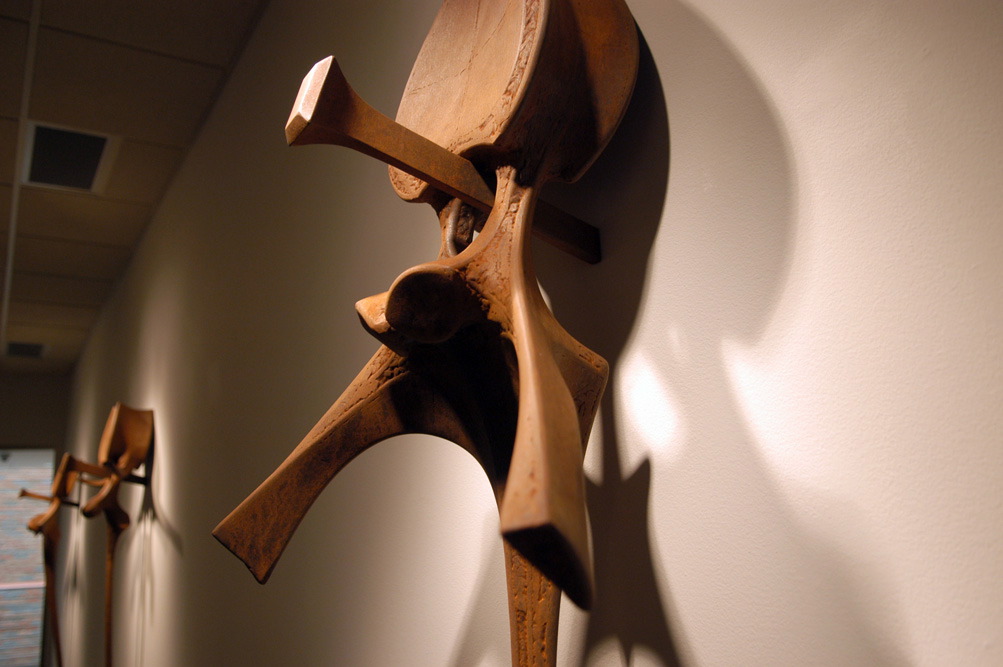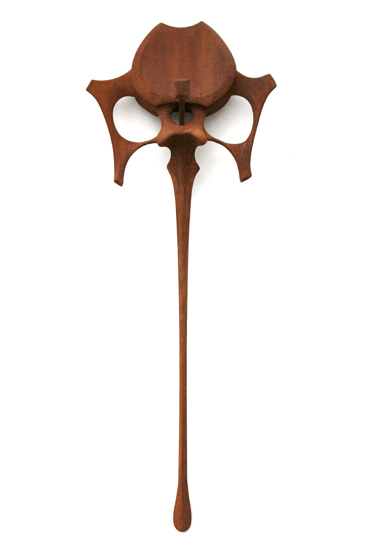Reliquiae: Beauty and Cruelty of Life on Earth
Glenn Gordon visited Sam Spiczka's sculptures at Augsburg College's Gage Family Gallery, and was swept away. The show is up through October 27. Spiczka is giving a talk at the gallery Weds, Oct 25, at 12:30 pm.




The Gage Family Gallery is a truncated wedge of space on the second floor of the Lindell Library of Augsburg College. The gallery is not large; trapezoidal in plan, it narrows as you move further into it, funneling your perception. For the display of art, there is something architecturally perfect about it. It encourages installations of concentrated aesthetic force. You would have to be dead not feel this force with some intensity the moment you enter the gallery’s current show, Reliquiae, an exhibit of nine works in welded and rusted Corten steel by the gifted young sculptor Sam Spiczka.
“Reliquiae,” from Latin, means “the remains of the dead,” or, in church parlance, “sacred relics,” the bones of saints. The origin of Spiczka’s reliquiae was his discovery, roaming the woods one day as a young boy, of the skeleton of a wild boar, weathered and whitened by the sun. He collected the vertebrae, ribs, skull, and appendages, and has studied them with deepening fascination ever since.
The pleasure he took at the bones’ beauty of form was countered by Spiczka’s revulsion as a child at the Church’s (he was raised Catholic) grisly preservation of human relics, not bleached clean like these by the sun but left to molder in the subterranean crypts of rotting old churches. At the same time that his reliquiae celebrate the organic structural harmony of vertebrae, sterna, and ribs, they confront the fundamental hideousness of torture and crucifixion, clearly symbolized in the cruciform shapes of most of these sculptures– unmistakably human in form and in scale.
Eight reliquiae hang on the gallery’s walls, each lit by two or three spots from above, the sharp shadows they cast emphasizing their projection off the wall. In keeping with the Latin, and as though numbered chapters of the sculptor’s own testament, the eight are titled with Roman numerals, denoting, presumably, the chronological order of their creation. Each work is six feet long and hangs from a single spike driven into the wall at an angle. Each is cruciform, iconic, essentially a variation on the single theme, speaking abstractly of the stripped ribs and vertebrae of that boar, but also of the remains of something hung on a meat-hook, shreds of flesh and cartilage still attached to its bones.
Spiczka’s skill is equal to his passion; the craftsmanship of these works of art is masterful. The sculptures are not cast in iron or carved of wood as first they might appear, but formed and fabricated from pieces of relatively thin sheet steel–essentially tailored together. Looking closely, you can see the welds that join segments ghosting through the surfaces, the rust at the seams slightly different in color, quietly acknowledging the process by which the works were made.
Although pieced together, the forms develop in ways completely bone-like. The result of careful observation, their chamfers, knobs, flanges, concave flutings and convex bulges all express the inevitabilities of organic growth. Like the stems of leaves, the long slender verticals projecting from the “torsos” first thin down, then flare towards the end into beautifully shaped, slightly asymmetrical terminations, the long stems gracefully curving back to touch the wall only down near the ends.
A few of the works in the series have outstretched, gestural “arms,” either like those on a crucifix or beckoning welcome, but others have no arms at all, or else arms that are only implied. None of the figures could be said to be emphatically and unambiguously the male Christ–most of them have protuberant knobs suggestive of the breasts of carved fertility effigies. If crucifixion is in fact meant, woman is granted equal time on the cross.
Each relic is surmounted by a head-like element, most of these in the shape of shields slightly concave on their faces and rimmed all around with the overlapping beads of the welding. I believe in the strict separation of church and steel myself, but some might be tempted to read these as crowns of thorns. In any case, there are throughout these extraordinary sculptures affecting passages of texture, in some places the welds reading like the scar tissue of burn victims, in others like carcasses not completely picked clean, or in yet others, like the surfaces, pitted by erosion, of bones left to the sky. The works are powerfully evocative of the violence of life on Earth.
Towards the rear of the Gage Gallery is a freestanding wall that masks off a row of windows. The space behind the wall forms a sort of vestibule, a discrete small secondary exhibition space slightly apart from the main area of the gallery. Spiczka’s only work not mounted on a wall in this show lies on the floor behind this baffle. Titled “Still life (he who was once a man of promise),” it consists of a large major element that might be the abstraction of the skull of an elephant. Attached to it is a chain made up of seven links each about a foot long, the chain ending in a kind of hook or shackle similar to those used to couple rail cars together. Lying on the floor near the end of this hook is a twelve-sided polyhedron—a dodecahedron, a solid whose every face is a regular pentagon (the geometric seed that germinated many of Spiczka’s earlier sculptures.) The mix of components is interesting, but compared to the ardent simplicity of the works on the walls, here they seem piled on, overloading the piece with an anxiety to mean something, thus draining its power.
Spiczka has also installed three large steel sculptures on the grounds outside around the library. Just beyond the construction site as you enter the campus on 22nd Ave. S. is a commanding work of oiled Corten steel about twelve feet high titled “Kubrick”–a tripod with stout tusk-like legs, their thick ends socketed to an armless trunk with variously faceted, curved, and hollowed surfaces. Standing before a building across the street is a work based on the form of a two-winged maple seed. Between the base of the piece and the cantilevered wings of the seed is a transitional knot of details that I find distracting, an openwork polyhedron caging what looks like a pair of colossal sparkplugs. The details complicate a work that might be stronger without them. But further down 22nd Ave., on a rise up to the right, stands one of Spiczka’s most beautiful works to date, a sculpture that without strain evokes the great Nike of Samothrace. A rising progression of forms each emerging as if it were the inevitable outcome of the one below, a sculpture fully realized from every angle, it is an inspiring sight, and will be, I think, for a long time to come.